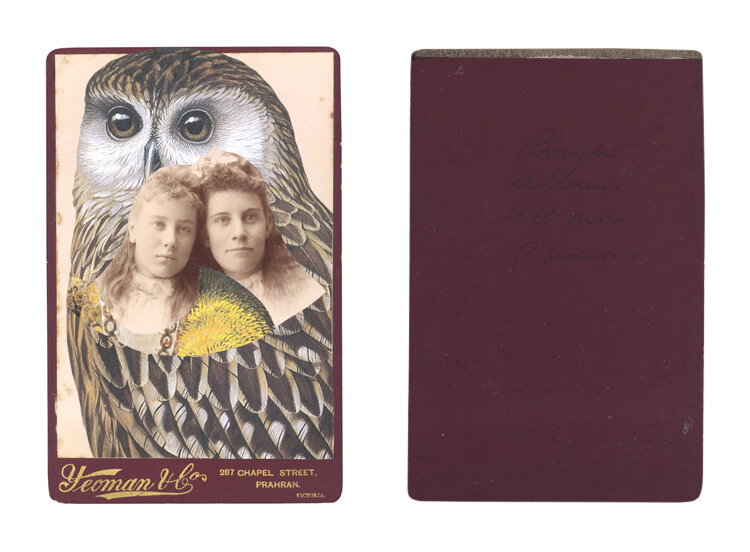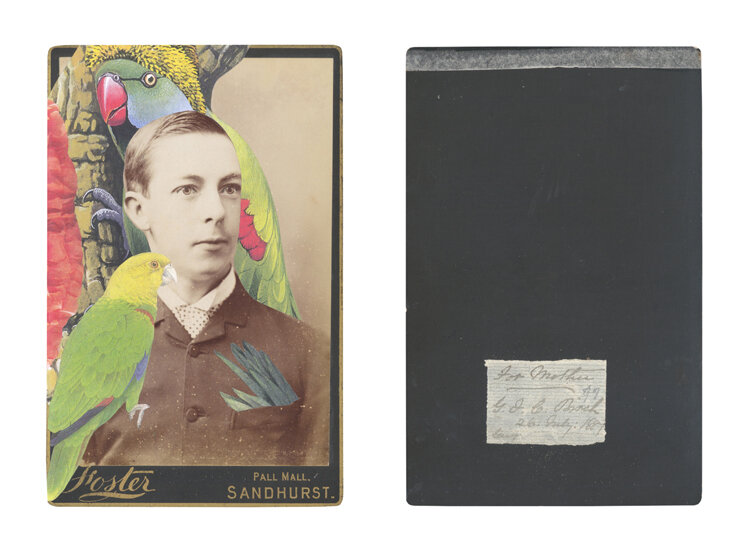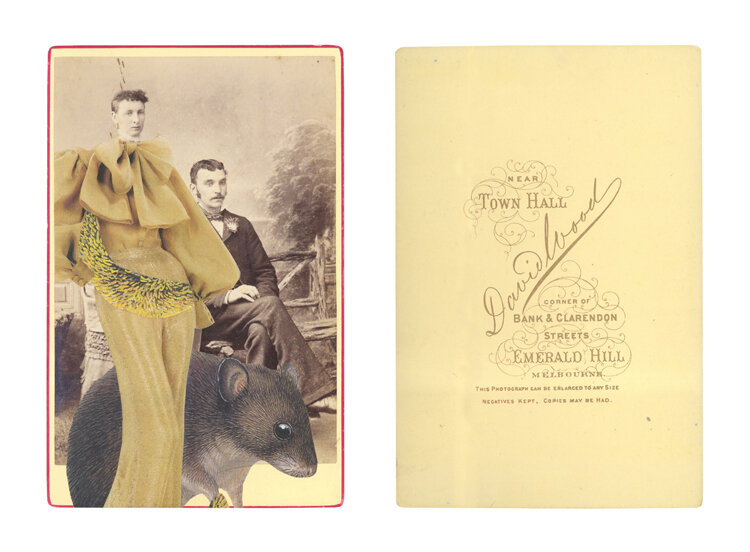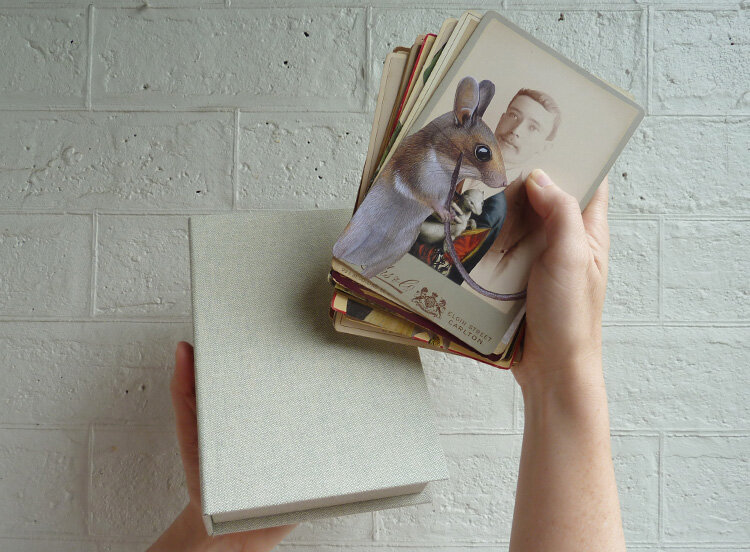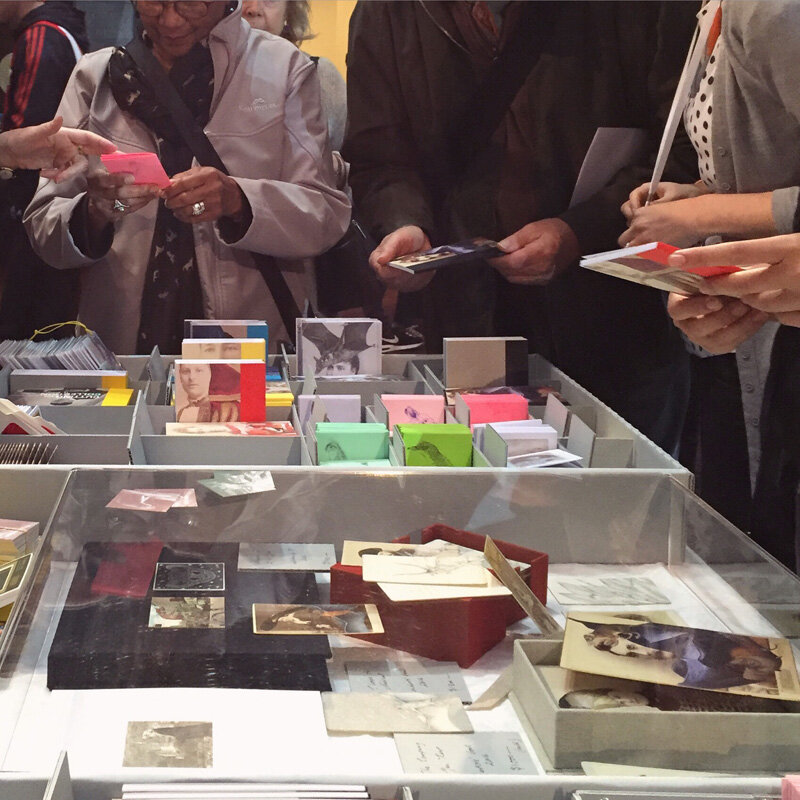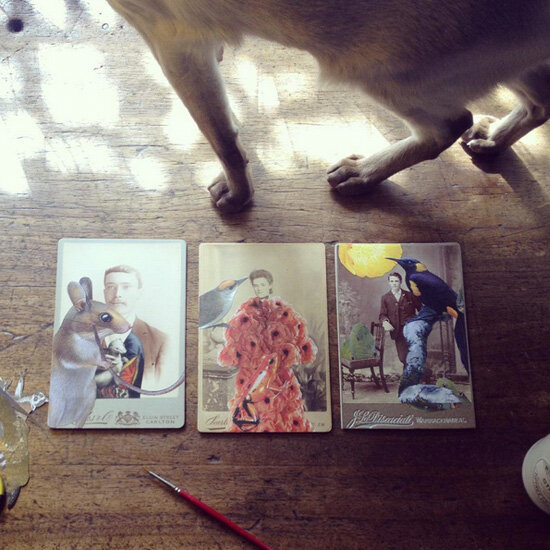THE COMPANY YOU KEEP
In the company of an extinct Short-tailed hopping-mouse (Notomys amplus) from Central Australia, and Leonardo’s ermine (Mustela erminea)
Gracia Haby & Louise Jennison
The Company You Keep
2016
Artists’ book, unique state, featuring 15 individual collages on cabinet cards with pencil (by Gracia Haby)
Housed in a linen Solander box (bound by Louise Jennison)
In Ballet Russes extension, across fifteen cabinet cards from photographic studios in Sydney Road, Brunswick to Charlemont & Co. High Art Photographers in Elizabeth Street, Melbourne, Salvaged Relatives appear in borrowed costumes designed by Gilbert Adrian and Arnold Scaasi (from the Brooklyn Museum Costume Collection at the Metropolitan Museum of Art), by way of Leonardo da Vinci’s Lady with an Ermine, and Anna May Wong's costume from the film Limehouse Blues, accompanied by extinct Short-tailed hopping-mice (illustrated by Peter Schouten) and Bornean smooth-tailed treeshrews (from the pages of the Longman Illustrated Animal Encyclopedia).
This artists’ book was released into the wild at the 2016 Melbourne Art Book Fair at the National Gallery of Victoria.
Catch us in conversation with Jess Cole, Assistant Curator Prints and Drawings, NGV, about the making of this artists’ book (2020).
In addition, this artists’ book of Yellow-headed parrots and Laughing owls was acquired by the National Gallery of Victoria.
1. In the company of an extinct Short-tailed hopping-mouse (Notomys amplus) from Central Australia, and Leonardo’s ermine (Mustela erminea)
2. In the company of a central Australian Desert rat-kangaroo (Caloprymnus campestris), last seen in 1935, and a Snowshoe hare (Lepus americanus)
3. In the company of the gentlest of owls, a Laughing owl (Sceloglaux albifacies), last seen in 1914
4. In the company of a Seychelles parakeet (Psittacula wardi), last seen in 1870
5. In the company of a Seychelles parakeet (Psittacula wardi), last seen in 1870, and a Yellow-headed parrot (Amazona oratrix)
6. In a borrowed evening ensemble of gold organdy, designed by Norman Norell, 1970–71, with a Darwin's rice-rat (Nesoryzomys darwini), last seen in 1929 on Indefatigable Island
7. Grandma Ferry in the company of a Nicobar pigeon (Caloenas nicobarica), in a photographic studio in Sydney Rd., Brunswick
8. In a borrowed costume of a Tigress, designed by Gilbert Adrian, 1949, with a Giant hummingbird (Patagona gigas)
9. In an offcut of a costume of a Tigress, designed by Gilbert Adrian, 1949, with a Kea (Nestor notabilis) in a photographic studio in South Melbourne
10. In a borrowed costume of a Tigress, designed by Gilbert Adrian, 1949, accompanied by a tiger (Panthera tigris)
11. In the company of an extinct Molokai ‘O’o (Moho bishopi) of the Hawaiian Islands, last seen in 1904
12. Florence Hunter in the company of an extinct Guadalupe caracara (Polyborus lutosus), last seen in 1900 by collector Rollo Beck
13. In the company of a nectar-loving Small Mauritian flying-fox (Pteropus subniger), last seen in the early 1800s, and a Bornean smooth-tailed treeshrew (Dendrogale melanura)
14. In a borrowed costume of silk organza poppies, designed by Arnold Scaasi, 1983, accompanied by a critically endangered Golden arrow-poison frog (Atelopus zeteki), and a Fire-crested alethe (Alethe castanea)
15. In the borrowed costume of dragon scales of overlapping gold and silver sequins, designed by Travis Banton for actress Anna May Wong in her role as Tu Tuan, a nightclub entertainer in the 1934 film, Limehouse Blues, and a Hawksbill (Eretmochelys imbricata)
●
﹏
RELATED LINKS,
LIVE IN-STUDIO ARTIST VISIT (NGV)
PACKING (SOMEONE'S) GRANDMA FERRY AND A NICOBAR PIGEON (CALOENAS NICOBARICA) IN THE LAST OF THE LIGHT
CLOSER TO NATURAL (2016)
THE COMPANY YOU KEEP, ZINE, 2016
A DECK OF SALVAGED RELATIVES (2015)
SALVAGED RELATIVES, EDITION I (2014–2015)
SALVAGED RELATIVES, EDITION II (2014–2015)
SALVAGED RELATIVES, EDITION III (2014–2015)
RELATED POSTS,
PAGE PREENING AND COSTUME TURNING
WHIRL, WHOOSH, SWOOP
FAIRGROUND BECKONS
WORK IN PROGRESS
TINKERING WITH PURPOSE
PINS IN SPIN
COSTUMED
Dear you
For those of you we are yet to meet, we are besotted with paper for its adaptable, foldable, cut-able, concealable, and revealing nature. In our artists’ books, prints, zines, drawings, and collages, we use play, and perhaps the poetic as well, to reel you in closer.
For us, above all, it is not the medium that is always of greatest import, but the message. And so, we use found photographs, collected postcards and acquired scenery in our artists’ books and zines, alongside our drawings and prints, and more recently, moving digital collages, for what they can enable us to say, and what we hope you might in turn feel. Though, of course, what you feel is entirely up to you, and to this end we favour open endings above all.
The animal is oft present and easily detectable, the centre of our paper stage. Hard to miss, over here and over there, the animal runs up hills, scales rooftops, and sometimes appears in the library considering flight. Gliding through a scene it is too large to be contained within or perhaps too manmade to call home, that it has a tail or feathers or furred muzzle is not solely why its form appears.
For us, the animal is there to question our very behaviour, those moral principles one governs the self by, and to explore our relationship with the natural world.
The two of us have been fans of the book for a long time now, and it is perhaps because no work is ever as you’d imagined or saw in your mind’s eye, that we keep working with books, paper, drawing, and collage. The way we approach digital collage is very much as the reader. Every step, every part of the process, every learning curve, holds us entranced. We love the challenge artists’ books and digital collage presents, the possibilities, the history they hold, and the intimacy they awaken. The flexible medium of the book holds us in its palm rather than us holding the book in our own palms. In the beginning, the medium of the artists' book seemed, to us, to be free of rules and regulations. It also presented many new things to consider, from page layout and sequence to typographical decisions, and such things we tossed in the air and arranged upon their landing. Working together has meant we were able to figure out the particulars through trial and error, and groundwork.
From the outset, we knew next to nothing of the logistics of binding, but a love of reading books, and a limited knowledge of the history of artists’ books, coupled with a brief stint in Switzerland to study experimental binding techniques (on a Freedman Foundation Travelling Scholarship in 2002), has guided us along the way. And blind faith, or whatever you wish to call it. At the back of our minds, the feeling that if we stuff this up, it has all been in vain, and this is a powerful motivator when joined with a love for what you are doing.
Yours in paper covered, Gracia & Louise

